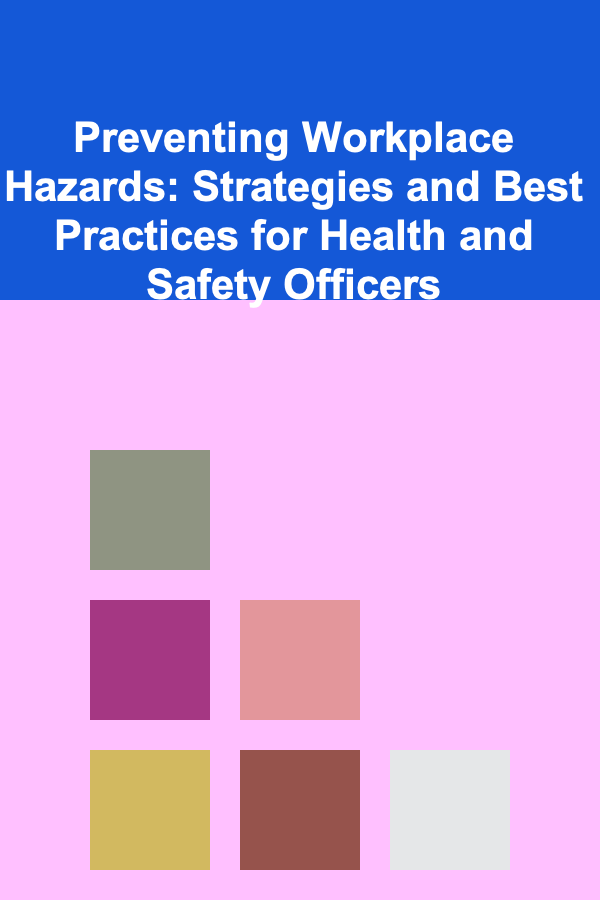
Preventing Workplace Hazards: Strategies and Best Practices for Health and Safety Officers
ebook include PDF & Audio bundle (Micro Guide)
$12.99$8.99
Limited Time Offer! Order within the next:

Workplace hazards, whether physical, chemical, biological, or ergonomic, present serious risks to employee health and safety. As Health and Safety Officers (HSOs), the responsibility of identifying, mitigating, and preventing these hazards is paramount to fostering a safe working environment. Implementing effective safety strategies and adhering to best practices is critical not only for compliance with regulations but for the well-being of workers and the overall productivity of the organization.
This guide explores in-depth strategies and best practices that Health and Safety Officers can adopt to prevent workplace hazards and ensure a safer environment for all employees.
Understanding Workplace Hazards
The first step in preventing workplace hazards is to have a thorough understanding of the different types of hazards that can arise in various environments. Workplace hazards can generally be categorized into several types:
- Physical Hazards: These include noise, vibration, radiation, and extreme temperatures.
- Chemical Hazards: Exposure to harmful chemicals such as solvents, fumes, and gases.
- Biological Hazards: Infections or diseases resulting from bacteria, viruses, or other biological agents.
- Ergonomic Hazards: Poorly designed workspaces or equipment that lead to musculoskeletal disorders.
- Psychosocial Hazards: Stress, harassment, and workplace bullying that can affect mental health.
Each category of hazard requires specific attention and strategies to prevent them from occurring or escalating.
Conducting a Comprehensive Hazard Assessment
A hazard assessment is one of the most crucial tasks for Health and Safety Officers. It involves identifying potential risks within the workplace, understanding their severity, and determining the likelihood of occurrence. By conducting regular and comprehensive hazard assessments, HSOs can proactively address issues before they result in accidents or injuries.
Steps for an Effective Hazard Assessment
- Identify Hazards: Walk through the workplace and observe activities, equipment, and processes. Consult employees about any concerns they have regarding their safety.
- Assess Risk: Evaluate the potential severity of each hazard. What is the impact of an accident caused by this hazard? Consider how likely it is to occur and how harmful it could be.
- Prioritize Hazards: After identifying and assessing the risks, prioritize them based on their severity and likelihood. Address the most pressing hazards first, especially those with a high potential for serious injuries or fatalities.
- Implement Control Measures: For each identified hazard, put control measures in place to reduce the risk. This might include using personal protective equipment (PPE), altering work processes, or installing safety features in equipment.
- Review and Update: Hazard assessments should not be static. As workplaces evolve, new hazards may emerge, and previous measures may become outdated. Regularly review and update hazard assessments to ensure ongoing safety.
Implementing Engineering Controls
Engineering controls are measures that eliminate or reduce exposure to hazards through physical changes to the workplace. These controls are often considered the most effective way to prevent workplace hazards, as they address the root cause of the problem.
Types of Engineering Controls
- Elimination or Substitution: The most effective engineering control is to remove the hazard altogether. If this isn't possible, substitute it with a safer alternative. For instance, replacing toxic chemicals with less harmful substances can significantly reduce chemical exposure.
- Isolation: Isolate the hazard from workers to reduce exposure. For example, using barriers or enclosures around noisy machinery or toxic fumes can limit workers' contact with the hazard.
- Ventilation: Proper ventilation systems can control exposure to airborne chemicals or dust. Local exhaust ventilation can remove contaminants at the source, while general ventilation improves air circulation in the workplace.
- Machine Safeguarding: Installing safety guards, automatic shut-off devices, and emergency stop buttons on machines can prevent accidents related to machinery operation.
Advantages of Engineering Controls
- Long-Term Effectiveness: Once implemented, engineering controls often continue to mitigate risk over the long term with minimal maintenance.
- Protection for All Employees: These controls can protect all workers, even those who are not directly exposed to the hazard, thereby reducing overall workplace risk.
Applying Administrative Controls
While engineering controls focus on the physical environment, administrative controls involve altering work policies and procedures to mitigate risks. Administrative controls are typically less effective than engineering controls but are still essential for managing hazards.
Types of Administrative Controls
- Job Rotation: Reducing exposure time to hazards by rotating workers through different tasks or shifts can help limit the amount of time any single worker is exposed to a specific hazard.
- Safety Procedures and Guidelines: Establishing and enforcing detailed safety protocols is essential. These guidelines should cover proper handling of hazardous materials, emergency procedures, and use of equipment.
- Signage and Warnings: Clear and visible signs indicating potential hazards (e.g., "Hazardous Area," "Wear PPE") can remind employees to take necessary precautions.
- Training and Education: One of the most effective ways to minimize human error is through continuous training. Employees must understand the risks they face, how to handle them, and the proper use of safety equipment. Regular refresher courses ensure that safety becomes an ongoing priority.
Challenges with Administrative Controls
- Reliance on Human Behavior: Unlike engineering controls, administrative controls depend on workers following procedures. This introduces the risk of non-compliance or human error, which can sometimes result in accidents.
- Limited Effectiveness: Administrative controls often do not eliminate the hazard but merely reduce exposure or mitigate its impact. This makes them less effective than engineering controls in many cases.
Providing Personal Protective Equipment (PPE)
Personal Protective Equipment (PPE) is the last line of defense against workplace hazards. PPE includes items such as helmets, gloves, eye protection, respirators, and hearing protection. While PPE is essential for workers who cannot be fully protected by engineering or administrative controls, it should always be considered as a supplement to, not a replacement for, these other measures.
Best Practices for PPE
- Assess the Need: Determine the specific hazards employees face in different roles and provide PPE accordingly. For example, construction workers may require hard hats, while lab technicians may need chemical-resistant gloves.
- Proper Fit and Comfort: PPE should be well-fitted and comfortable to ensure that workers wear it consistently. Ill-fitting or uncomfortable PPE can lead to non-compliance.
- Training on Use: Provide training on the correct use, maintenance, and disposal of PPE. Employees must understand how to use it effectively to maximize protection.
- Maintenance and Inspection: Regularly inspect and maintain PPE to ensure it remains functional. Worn-out or damaged equipment should be replaced immediately.
Fostering a Safety Culture
Creating a culture of safety within the organization is perhaps the most powerful strategy for preventing workplace hazards. When safety becomes ingrained in the company culture, every employee becomes a part of the safety effort, leading to a collective responsibility for hazard prevention.
Strategies for Fostering Safety Culture
- Lead by Example: As an HSO or leader, it is crucial to demonstrate commitment to safety. Follow all safety protocols and actively engage with employees on safety matters.
- Encourage Reporting: Create an open environment where employees feel comfortable reporting hazards or unsafe conditions without fear of retaliation.
- Employee Involvement: Involve employees in safety discussions, hazard identification, and decision-making processes. Workers who feel invested in safety initiatives are more likely to follow procedures and promote a safe working environment.
- Recognition and Incentives: Reward employees for their contributions to safety, whether through recognition programs or incentive-based systems. Positive reinforcement helps sustain the focus on safety.
Continuous Monitoring and Improvement
Preventing workplace hazards is an ongoing process. Regular monitoring, feedback, and improvements are necessary to keep the workplace safe.
- Conduct Regular Inspections: Regularly inspect the workplace to identify new hazards or assess the effectiveness of existing control measures.
- Track Incidents and Near Misses: Investigate all accidents, injuries, and near misses. Even if no injury occurred, near misses can provide valuable insights into potential hazards that need to be addressed.
- Stay Updated with Regulations: Occupational health and safety regulations can evolve over time. Keep up-to-date with local, national, and international safety standards to ensure continued compliance.
Conclusion
Preventing workplace hazards is a continuous and dynamic process that requires a combination of risk identification, engineering solutions, administrative controls, proper PPE, and a culture of safety. Health and Safety Officers play a critical role in shaping and maintaining a safe work environment. By adopting these strategies and best practices, HSOs can significantly reduce workplace hazards, protect employees, and enhance the overall productivity and morale within the organization. The ultimate goal is to ensure that every worker returns home safe and healthy at the end of the day.

How to Make Homemade Hot Sauce
Read More
How to Optimize Your One-Page Website for SEO
Read More
How to Save Big: Tips for Reducing Food Delivery Expenses on a Budget
Read More
How to Store Shoes Efficiently in a Small Home
Read More
Why Organizing the Entryway Sets the Tone for Your Home
Read More
How to Integrate Yoga Nidra into Your Sleep Routine
Read MoreOther Products

How to Make Homemade Hot Sauce
Read More
How to Optimize Your One-Page Website for SEO
Read More
How to Save Big: Tips for Reducing Food Delivery Expenses on a Budget
Read More
How to Store Shoes Efficiently in a Small Home
Read More
Why Organizing the Entryway Sets the Tone for Your Home
Read More